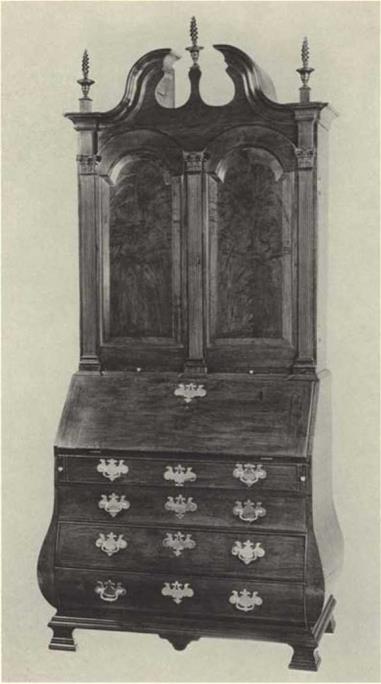The word "bombe” is a recent term taken from the French verb bomber, meaning to bulge or jut our. The wrotd had been used to describe both French and English furniture in the nineteenth century. The first publication to use the word to describe American furniture is Esdier Singleton’s Furniture of Our Forefathers (New York, lQOi), where it is italicized and an obvious French importation, Luke Viti-
|
|
56. СнеіТ-<Ж-Сн£!іт. Баиоп ігеа, с. 1740-1760. Mahogліу, thfiimui, jttd wlitie pine; Н, #7% inches, W. 4}’/7 inches, е>. 2г1/* inches, (YiJt University Art Gillery, Mibol Bddy Girvin Collection.)
|
|
97. Пи і к and Bookcase, Made by Benjamin Frorhinghim, md П. Sprig? (signature in pendt), В won or Charlestown, 1753. Mahogany, red cedar, Bid white pine; n £7% indiei, w. 44′,^ inches, d. 24% inehei. (The Department of State, Washington, D. C.: photo, Israel Sack, Inc., New York City,) See also fjg. 162,
cent Lock woo J uses "fwMiin^shaped" to describe a desk in Colonial American Fundture (New York, 1913). “Kettle shape,” the other term used to describe die form, first appears 111 Frances Clary Morse’s FitmrtuK of the Olden Time (New York. 1902) and is often used by later authors such as Charles Over Cornelius (Tarty American Furniture [New York, 1926]) in conjunction with the word "bombA" Although it may seem stilted, "bombt" better connotes the original spirit which gave rise to the form than the word "kettle," and is dius used throughout this paper,
Eighteenth-century manuscripts demonstrate the lack of a specific designation for the bombd form. Inventories of individuals known to have owned bom be furniture offer an unillumiuating file of "desks and bookcases" or "chests of drawers" occasionally prefaced by "large,” "carved," or "mahogany," A hill for joiner’s work on the pulpit of Christ Church, Spitalfields, London, in 1725-1726, offers one contemporary possibility. It states that the pulpit, which had a distinct bombd shape, is "of right "Wamt [wainscot | formed Oggee faslion the Pannclls fmeerd & inlaid."3 In this case, the bom be design is called "Oggee fashon," Ogee being an architectural term for die eyma reversa. The svord "ogee” occasionally appears as a descriptive term in American documents, such as the 1776 shop inventory of the Charlestown cabinetmaker Thomas Wood, J but it is difficult to determine how inclusive the usage was or what furniture was being described.
The English seem to prefer the French word commode to describe the bomb£ shape, although this cannot be interpreted as a standard term. In the eighteenth century’, the most popular use of the bomb£ form was ОП thetascpiccc of two or three drawers. First appearing in France, the new furniture form was given the name commode en tom – beau—literally, "commode in the style of a sarcophagus." The design was derived from classical sarcophagi. The form was plus commode
a. Quilled in iun’f^i/Ijiidiifi: Spital fields and Mite End New ТЬмті, xxvn (London, ~93- L’llurtny of Mr. Нетто M. Forman.
]. Mabel M. Swjn, 1 ’Fumituremikers of ChirlcrtownAntiques. HVt (Odobfl,
■mk aoj-aor.
(more convenient) for storing clothes than the simple chest.* The fashionable French chest of drawers with bulging sides, simply called a commode, spread throughout Europe. Great Britain soon began producing the bombe form on chests of drawers, some of which copied French furniture while others took a profoundly British cast. The word “commode” entered the English vocabulary as a description of the new style of casepicces, a usage which became available in print to the American colonists in Thomas Chippendale’s The Gentleman and Cabinet-Maker t Director, The 1754 edition illustrates both “French Commodes” (fig* 11 в) modelled on mid-eighteenth-een – rnry French furniture,3 and a tall clock (fig, 98} described as having a commode pedestal which is identical in form to die bombe furniture of Boston,
The most logical explanation for the inexact terminology is that an individual word was unnecessary to describe a new furniture form that appealed to a small elite clientele isolated in colonial Boston. In eighteenth-century Boston inventories the word “commode” appears most frequently in reference to the commode chair. Occasional inventories list commode chests or other cascpieccs, but die exact form is impossible to determine. Tile adjective “swell’d" is knowrn to have been used to describe both the block front and serpentine front on casepieces. Either of these terms may have been util і red for the bombe shape as well; the prospective purchaser would then describe the chosen “swell’d" or “commode" form to the cabinetmaker.


